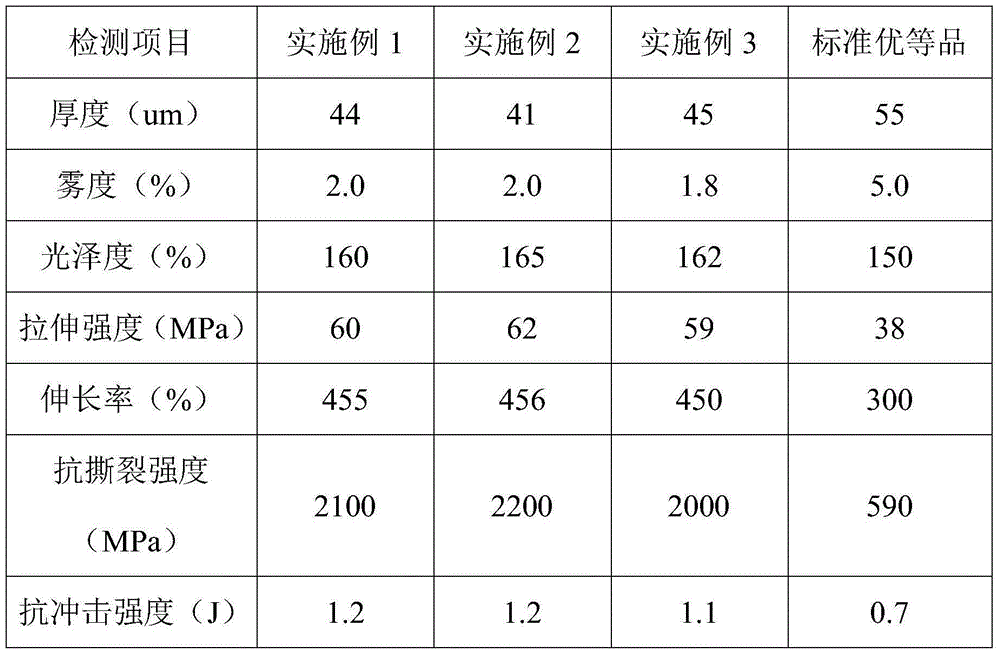A kind of production technology of heat-shrinkable polyester film
A polyester film and production process technology, applied in the production process field of heat-shrinkable polyester film, can solve the problems of hydrolysis and degradation to generate air bubbles, unfavorable recycling treatment, bonding blocks, etc., to prevent hydrolysis degradation and generation of air bubbles, avoid heating Too fast to avoid the effect of sticking to each other
- Summary
- Abstract
- Description
- Claims
- Application Information
AI Technical Summary
Problems solved by technology
Method used
Image
Examples
Embodiment 1
[0036] The process is divided into seven steps. Firstly, (1) slicing: first, the material extraction process is carried out, and the material obtained is non-crystallized polyethylene terephthalate, and then the raw material transportation process is carried out, and finally the pre-crystallization process is carried out, and then the (2) Vacuum drying: The equipment used is a vacuum drum dryer, heated to 70°C, and the holding time is 6h, and then carried out (3) Melt extrusion: The equipment used is a single-screw extruder, and the screw speed is adjusted to 62r / min, heating up, the temperature is sequentially increased to 170°C, 230°C, 258°C, 268°C, 274°C, each temperature is maintained for 10 minutes, and then (4) quenching casting: first conduct the melting process, divide It is three steps of metering, filtration and casting, and then the molding process: the first step, electrostatic adsorption, the second step, cold drum: add distilled water, adjust the temperature to 25...
Embodiment 2
[0038] Repeat Example 1 according to the same steps described, the difference is: step (2) vacuum drying: heating to 75 ° C, holding time is 7h, step (3) melt extrusion: screw speed is adjusted to 66r / min , the temperature is sequentially increased to 175°C, 235°C, 260°C, 270°C, 275°C, each temperature is maintained for 15 minutes, step (4) quenching casting: longitudinal stretching: in the cold drum process, add distilled water and adjust the temperature to 30°C, step (5) biaxial stretching: in the preheating process, the temperature is 72°C, in the stretching process, the temperature is 83°C, in the cooling process, the temperature is 32°C, in the pressing roll process, the temperature is 95°C, Transverse stretching: In the stretching process, first adjust the temperature to 95°C, keep it for 25 minutes, then adjust the temperature to 107°C, in the cooling process: adjust the temperature to 85°C, step 6) cooling: heat up at a heating rate of 35°C / h to 165°C and hold for 35 m...
Embodiment 3
[0040] Repeat Example 1 according to the same steps described, the difference is: step (2) vacuum drying: heating to 80 ° C, holding time is 8h, step (3) melt extrusion: screw speed is adjusted to 70r / min , the temperature is sequentially increased to 180°C, 240°C, 262°C, 272°C, 276°C, each temperature is maintained for 20 minutes, step (4) quenching casting: longitudinal stretching: in the cold drum process, add distilled water and adjust the temperature to 35°C, step (5) biaxial stretching: in the preheating process, the temperature is 85°C, in the stretching process, the temperature is 85°C, in the cooling process, the temperature is 35°C, in the pressing roll process, the temperature is 100°C, Stretching: In the stretching process, first adjust the temperature to 100°C, keep it for 30 minutes, then adjust the temperature to 110°C, in the cooling process: adjust the temperature to 90°C, step 6) Cooling: raise the temperature at a heating rate of 40°C / h to 170°C and keep for...
PUM
 Login to View More
Login to View More Abstract
Description
Claims
Application Information
 Login to View More
Login to View More - R&D
- Intellectual Property
- Life Sciences
- Materials
- Tech Scout
- Unparalleled Data Quality
- Higher Quality Content
- 60% Fewer Hallucinations
Browse by: Latest US Patents, China's latest patents, Technical Efficacy Thesaurus, Application Domain, Technology Topic, Popular Technical Reports.
© 2025 PatSnap. All rights reserved.Legal|Privacy policy|Modern Slavery Act Transparency Statement|Sitemap|About US| Contact US: help@patsnap.com

